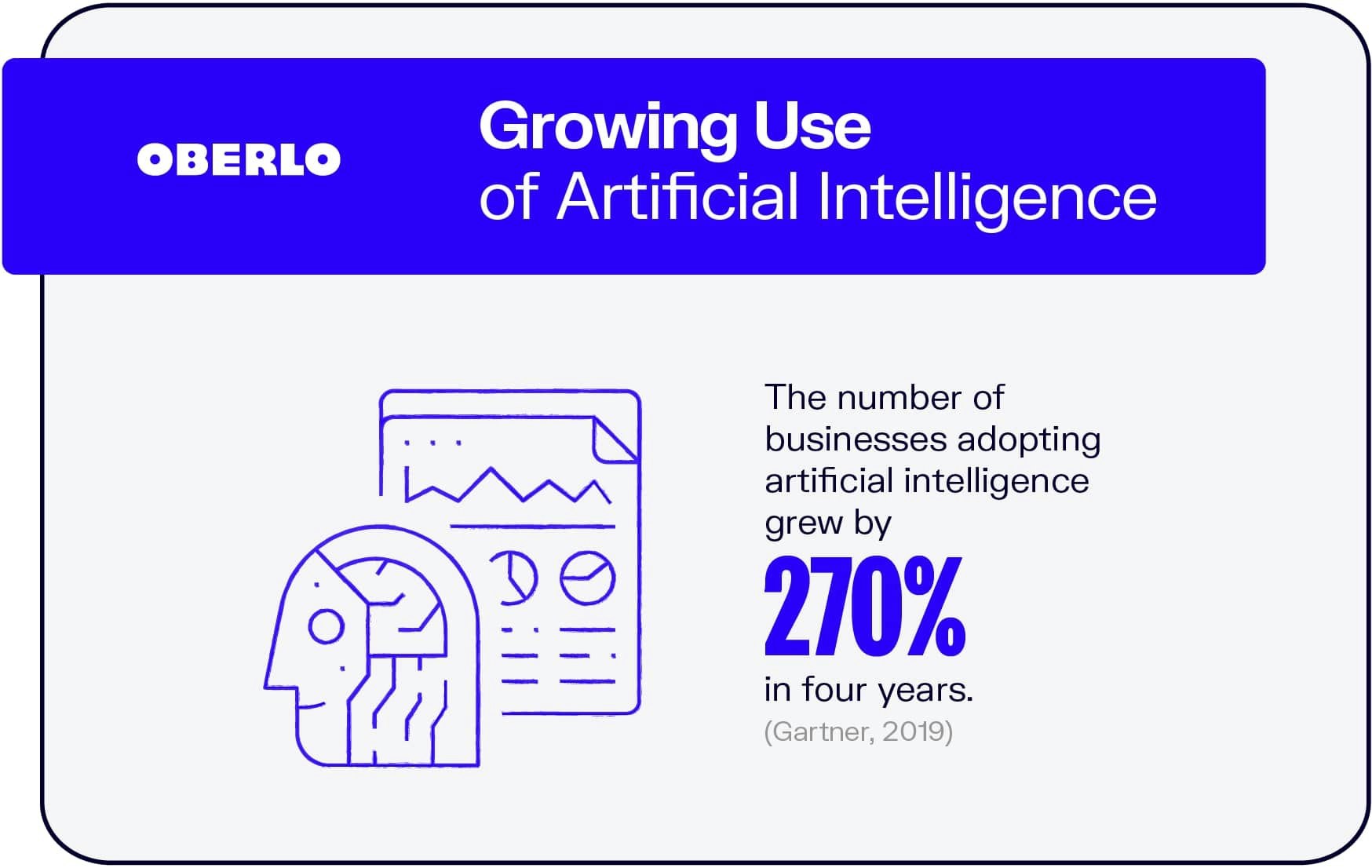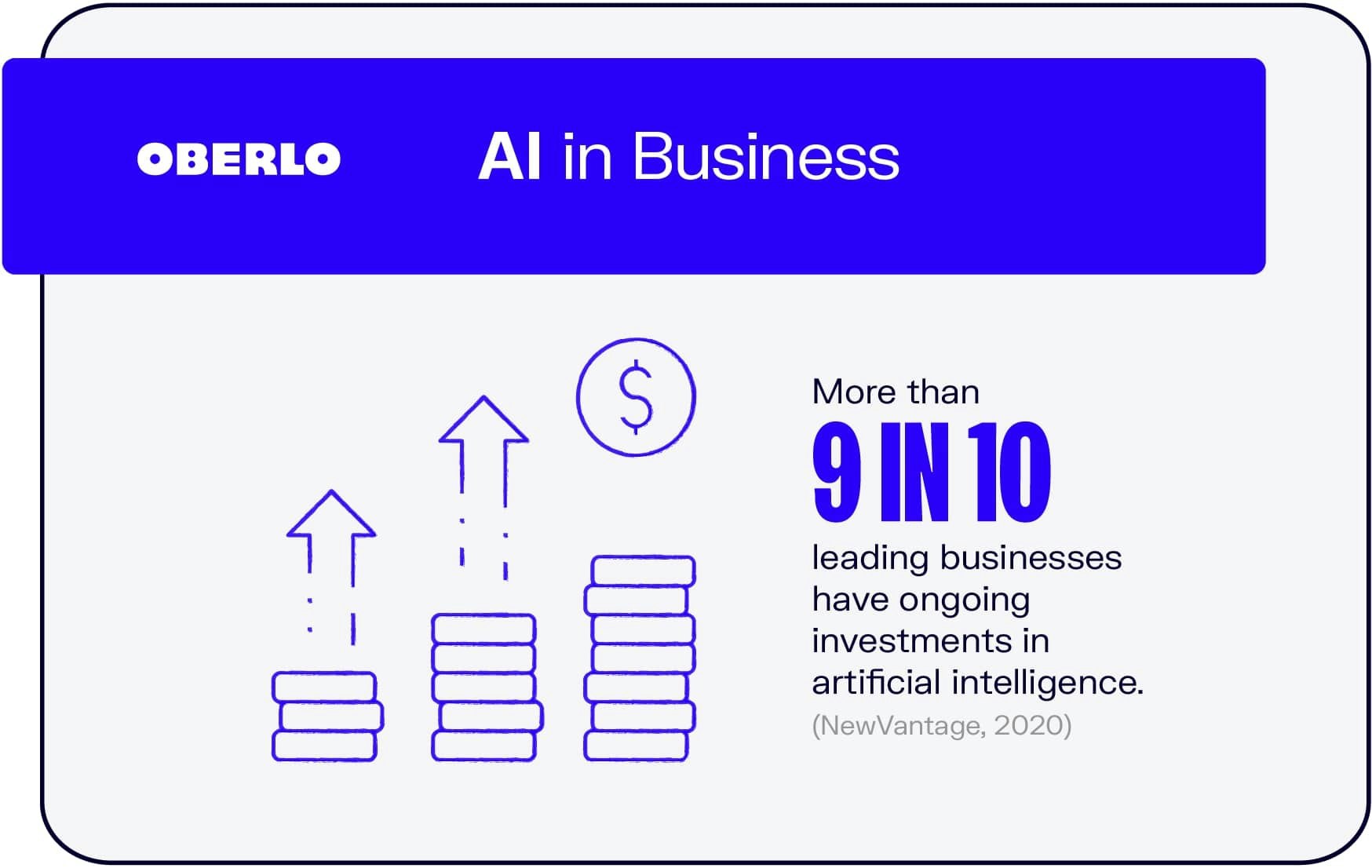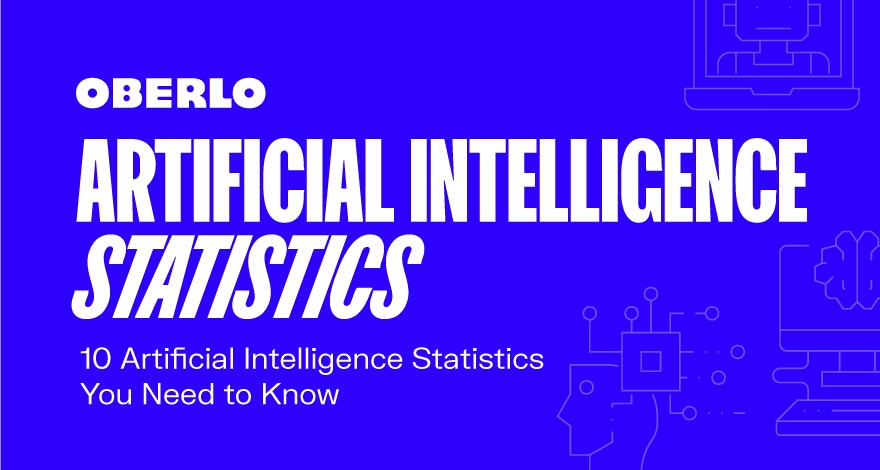Artificial Intelligence (AI) is one of the fastest-growing and popular data-driven technologies being used all around the world.
From governments and large organizations to small online businesses, artificial intelligence is being used by multiple entities across the world.
What’s the role of AI in businesses? What do consumers think about the technology? And how can you use it to power sales?
In this article, we’ll dive into the ten most important artificial intelligence statistics you need to know in 2021 and cover everything from the use of AI in businesses to the advantages it brings.
Ready? Let’s get to it.
Post Contents
- 1. Growing Use of Artificial Intelligence
- 2. Artificial Intelligence Growth
- 3. AI in Business
- 4. AI in Business Productivity
- 5. Customers Willing to Use AI to Improve Their Experiences
- 6. The Power of AI in Customer Service
- 7. Artificial Intelligence Statistics in Sales
- 8. Cost Benefits of Adopting AI in Businesses
- 9. AI-Powered Voice Assistance Usage Growth
- 10. Trust Is Critical for AI Deployment
- Conclusion
- Summary: Artificial Intelligence Statistics
- Want to Learn More?

Don’t wait for someone else to do it. Hire yourself and start calling the shots.
Get Started Free1. Growing Use of Artificial Intelligence

Although the use of AI remains relatively low across organizations, statistics show that an increasing number of enterprises are starting to employ it within their business operations.
In 2015, just ten percent of organizations reported that they either already used artificial intelligence technology or would be doing so in the near future. Fast forward to 2019 and that number rose to 37 percent, which means that more than one in three organizations are either using artificial intelligence or have plans to do so (Gartner, 2019).
This represents an impressive 270 percent growth in just four years. Most of this growth came from 2018 to 2019, during which the usage of AI within organizations as much as tripled.
In fact, it’s clear that organizations are starting to pay more and more attention to the power of artificial intelligence. It’s been named the most disruptive technology by chief intelligence officers and IT leaders worldwide, surpassing data and analytics.
2. Artificial Intelligence Growth

With the growing implementation of artificial intelligence among organizations, it should come as no surprise that the market size of AI is set to increase dramatically.
The latest data shows that the market size of artificial intelligence was valued at $27.23 billion in 2019 (Fortune Business Insights, 2020). This figure is projected to reach $266.92 billion by 2027—a nearly tenfold increase in just eight years and with a Compound Annual Growth Rate (CAGR) of 33.2 percent.
One of the driving forces behind this impressive artificial intelligence growth is expected to come from businesses adopting it to power customer engagement. More and more, companies are relying on AI to provide customers with more personalized services. Coupled with the growing emphasis on customer services, implementation of AI to serve customers will only increase.
According to industry analysts, healthcare will be one of the biggest sectors to benefit from the applications of AI. This is particularly so during the coronavirus pandemic, during which artificial intelligence can provide more accurate diagnoses and in turn, more efficient treatments.
3. AI in Business

The above two artificial intelligence statistics are proof of its widespread adoption by businesses. But as we’ll see, the growing use of artificial intelligence is even more prevalent among leading companies around the globe and in particular the financial and healthcare sectors.
Artificial intelligence statistics from a recent survey show that more than nine in ten (91.5 percent) top businesses surveyed report having an ongoing investment in AI (NewVantage, 2020).
Most of the companies surveyed belong to the financial services sector, but participants also include other leading firms like Google and General Motors and healthcare companies like Pfizer and CVS Health.
Although many of these companies have active investments in AI, the use of AI within their companies is considerably modest. Just 14.6 percent of them are using the technology extensively within their organization. In comparison, more than half (51.2 percent) have AI deployed to limited production and just over one in four (26.8 percent) is piloting it.
4. AI in Business Productivity

The growing use of artificial intelligence by companies shows that there are plenty of benefits to be reaped.
One of such benefits is improved productivity as tedious, repetitive, and routine tasks can be offloaded to AI, allowing employees to spend more time on analysis.
Statistics show that 54 percent of business executives say that their adoption of AI within the workplace has led to a boost in productivity (PWC, 2018).
As the saying goes, two heads are better than one. Such effective use of AI also helps with better and more accurate decision-making within organizations. As many as two-thirds of executives say AI can improve and strengthen collaboration between humans and machines.
5. Customers Willing to Use AI to Improve Their Experiences

The growing use of artificial intelligence isn’t just widespread in businesses. As the technology goes mainstream, consumers worldwide have become more receptive and accepting of it.
The latest artificial intelligence statistics show that as of 2019, 62 percent of consumers say they are willing to use AI to improve their experience (Salesforce, 2019). That’s an uptick from 59 percent in 2018.
Businesses, however, will need to work on communicating how they’re using AI within their organizations. Despite growing acceptance of AI, many consumers remain wary over how businesses are using the technology.
Just over half (54 percent) of them say they trust companies to use the data collected from AI in a way that’s beneficial to consumers, while only over one-third (39 percent) say companies are transparent enough about the way they’re using AI.
6. The Power of AI in Customer Service

As the above artificial intelligence statistics have shown, AI is permeating all walks of business and customer service is no exception.
The latest statistics show that by 2021, as many as 15 percent of customer service interactions worldwide will be fully powered by AI (Gartner, 2019). That’s a whopping 400 percent increase from as recently as 2017.
Areas within customer service in which AI is currently being used include bots and virtual customer assistants. In fact, nearly one in four (23 percent) of customer service organizations currently use AI-powered chatbots.
These allow for a larger capacity to handle queries, a more efficient interaction due to quicker chat speeds in real-time, and more control over the data collected from consumers.
Such benefits are becoming crucial for companies as consumers’ demands for better customer service experiences grow. For instance, 71 percent of consumers expect to be able to communicate with businesses in real-time.
7. Artificial Intelligence Statistics in Sales

Customer service aside, sales departments across many organizations have also implemented artificial intelligence in their day-to-day work.
In 2018, 21 percent of sales teams were using artificial intelligence (Salesforce, 2019). This figure is set to soar by 155 percent in two years. By 2020, 54 percent of them are expected to be using the technology.
The rapid adoption of AI is the fastest of any other technology used by sales teams. In comparison, the use of marketing automation is forecast to increase by 104 percent, and the adoption of a partner relationship management system at 95 percent.
These are likely to be implemented within processes such as automation and quote configuration tools. These will help salespeople to better understand the needs of their consumers. With tedious tasks out of the way, they can work on being better advisors to them.
Going forward, the majority of sales teams are forecasting that AI capabilities will improve over the next five years to provide more enhanced data. Seven out of ten high-performing salesmen expect better intelligence forecasting, while 66 percent expect improved opportunity insights and better lead prioritization.
8. Cost Benefits of Adopting AI in Businesses

From the above artificial intelligence statistics, it’s clear that the important role of AI in businesses cannot be denied. But improvements to customer service and sales aside, there’s also a financial incentive for companies to adopt AI.
According to the latest artificial intelligence facts and statistics, 44 percent of firms using AI report a reduction in business costs in departments where AI is implemented (McKinsey, 2019). Coupled with a growth in revenue by many of these organizations, the cost benefits of AI are clear.
The biggest cost savings have come from manufacturing operations: 37 percent of companies saw manufacturing costs decrease by up to ten percent following AI implementation. This is followed by the risk and supply-chain departments, both of which saw costs fall by 31 percent.
Most revenue increases came from the marketing and sales departments. Four in ten of them say revenue grew by up to five percent after the adoption of AI.
Service operations and product and service development teams also saw substantial increases in revenue at 31 percent.
9. AI-Powered Voice Assistance Usage Growth

One of the most popular uses of artificial intelligence has come in the use of voice-assisted devices and data shows that this trend will only grow in the coming years.
In fact, the number of AI-powered voice assistants is expected to reach 8 billion by 2023 (Statista, 2019). This is more than the global population, an indication that users of voice assistants are likely to own more than one such device.
It also marks an increase of 4.75 billion from the 3.25 billion digital voice assistants worldwide in 2019, and a whopping 146 percent increase in just four years.
It’s estimated that in the United States alone, there are over 110 million users of virtual assistants, with devices like smartphones and smart speakers proving to be particularly popular.
One common usage of these AI-powered voice assistants is for online shopping. As it stands, 43 percent of owners of voice-assisted devices aged between 45 and 60 in the US currently use it to purchase items online.
10. Trust Is Critical for AI Deployment

Not only is trust important for consumers whose data is being collected and analyzed by artificial intelligence, organizations say they must be able to trust the technology’s recommendations.
More than three out of four (78 percent) companies say that it is important that results obtained from AI are “fair, safe, and reliable” (IBM, 2019). Even more of them (83 percent) place emphasis on understanding its algorithm—that is, that they want to understand how the technology arrived at its conclusion and be able to explain it.
This comes as no surprise, considering that the data from AI affects decision-making. For businesses, this may affect sales and marketing strategies, human resources and hiring, and even more critical strategies like company growth and expansion.
To ensure AI data is reliable, companies should consider implementing a system that includes checks of impartiality, transparency, responsibility and accountability, having the right security measures in place, constant tracking of reliability, and the protection of customer data.
Conclusion
We hope that these ten artificial intelligence facts were able to help you understand the direction in which businesses are heading when it comes to the latest data-driven technology.
Though the benefits of AI in businesses are undeniable, there are many issues to consider when implementing them.
Be it for sales, marketing, or customer service, you may now go forth and put these artificial intelligence statistics to good use when building your ecommerce store.

Summary: Artificial Intelligence Statistics
Here’s a summary of the Artificial Intelligence statistics you need to know in 2021:
- The number of businesses adopting artificial intelligence grew by 270 percent in four years.
- The global artificial intelligence market is expected to reach $267 billion by 2027.
- More than nine in ten leading businesses have ongoing investments in artificial intelligence.
- More than half of businesses have reported a boost in productivity after having implemented AI.
- 62 percent of consumers are willing to submit data to AI to have better experiences with businesses.
- 15 percent of all customer service interactions globally is expected to be fully powered by AI by 2021.
- Nearly one in four sales teams currently use artificial intelligence in their day-to-day work.
- 44 percent of organizations have reported cost savings as a result of AI implementation.
- The number of AI-powered voice assistants is forecast to reach 8 billion by 2023—a 146 percent increase from 2019’s 3.25 billion.
- More than three in four businesses say it is important for them to be able to trust AI’s analysis, results, and recommendations.
Want to Learn More?
- WooCommerce vs. Shopify: Which Is the Better in 2021?
- 11 Best Free PDF Editor Tools in 2021
- Instagram Stories: The Ultimate Beginners Guide for 2021
- 10 Virtual Reality Statistics You Need to Know [Infographic]
Is there anything else you’d like to know about Artificial Intelligence statistics and wish was included in this article? Let us know in the comments below!




